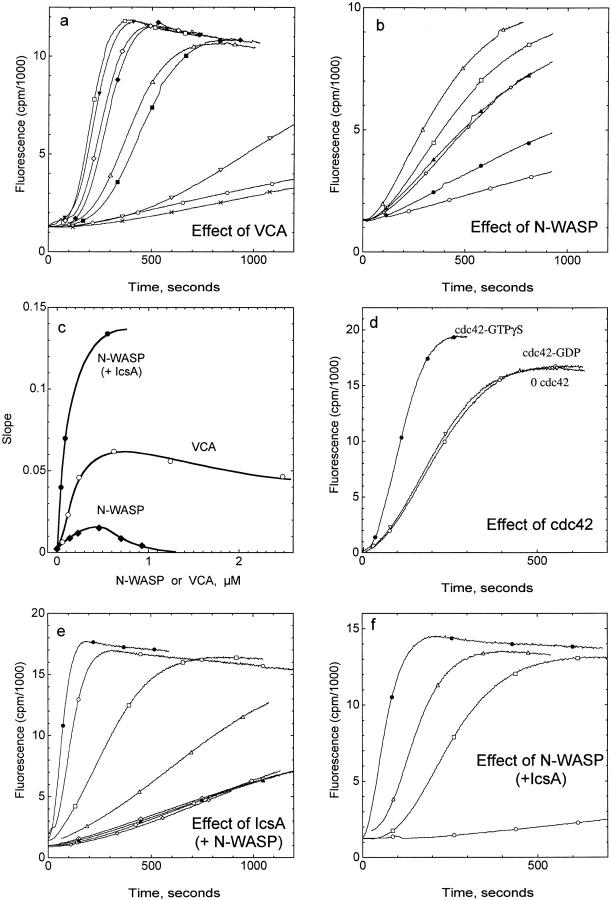Figure 4.
IcsA mimics Cdc42 in activating N-WASP and stimulating actin polymerization by Arp2/3 complex. Mg-G-actin (2.5 μM, 9% pyrenyl-labeled) was induced to polymerize by addition of 0.1 M KCl and 1 mM MgCl2 in the presence or absence of Arp2/3 complex (9.5 nM) and other reagents as indicated. a, VCA activates Arp2/3 complex. ×, Control (actin alone). For all other curves, Arp2/3 (9.5 nM) and VCA are at the following concentrations: ○, 0; ▿, 0.06 μM; ▵, 0.12 μM; ⋄, 0.24 μM; □, 0.62 μM; ▾, 1.24 μM; ♦, 2.48 μM; ▪, 3.7 μM. b, N-WASP activates Arp2/3 complex. Same conditions as in a, except N-WASP varied as follows: ○, 0; ⋄, 0.115 μM; □, 0.23 μM; ▵, 0.46 μM; ▴, 0.70 μM; •, 0.93 μM. c, Dependence of the activation of Arp2/3 on VCA and N-WASP concentrations. The maximum rate of polymerization recorded in panels a, b, and f (in the presence of IcsA) is plotted versus the concentrations of VCA (○) or N-WASP (•). d, Cdc42 activates N-WASP–Arp2/3 complex. Same as in b, with 0.2 μM N-WASP, in the absence (▵) or in the presence of GDP-Cdc42 (○) or GTPγS-Cdc42 (•). e, IcsA activates N-WASP–Arp2/3 complex. Actin was polymerized alone (▴); in the presence of 19 nM Arp2/3 (○), 0.25 μM IcsA (⋄) or 0.13 μM N-WASP (small ⋄); in the presence of Arp2/3 and 0.25 μM IcsA (▵); Arp2/3 and 0.13 μM N-WASP (□); Arp2/3, 0.13 μM N-WASP and 30 nM (○), or 0.25 μM (•) IcsA. f, Activation of Arp2/3 complex by N-WASP is more pronounced in the presence of IcsA. Actin was polymerized in the presence of Arp2/3, 0.1 μM IcsA and 0 (○), 0.042 μM (□), 0.087 μM (▵), and 0.55 μM (•) N-WASP.

